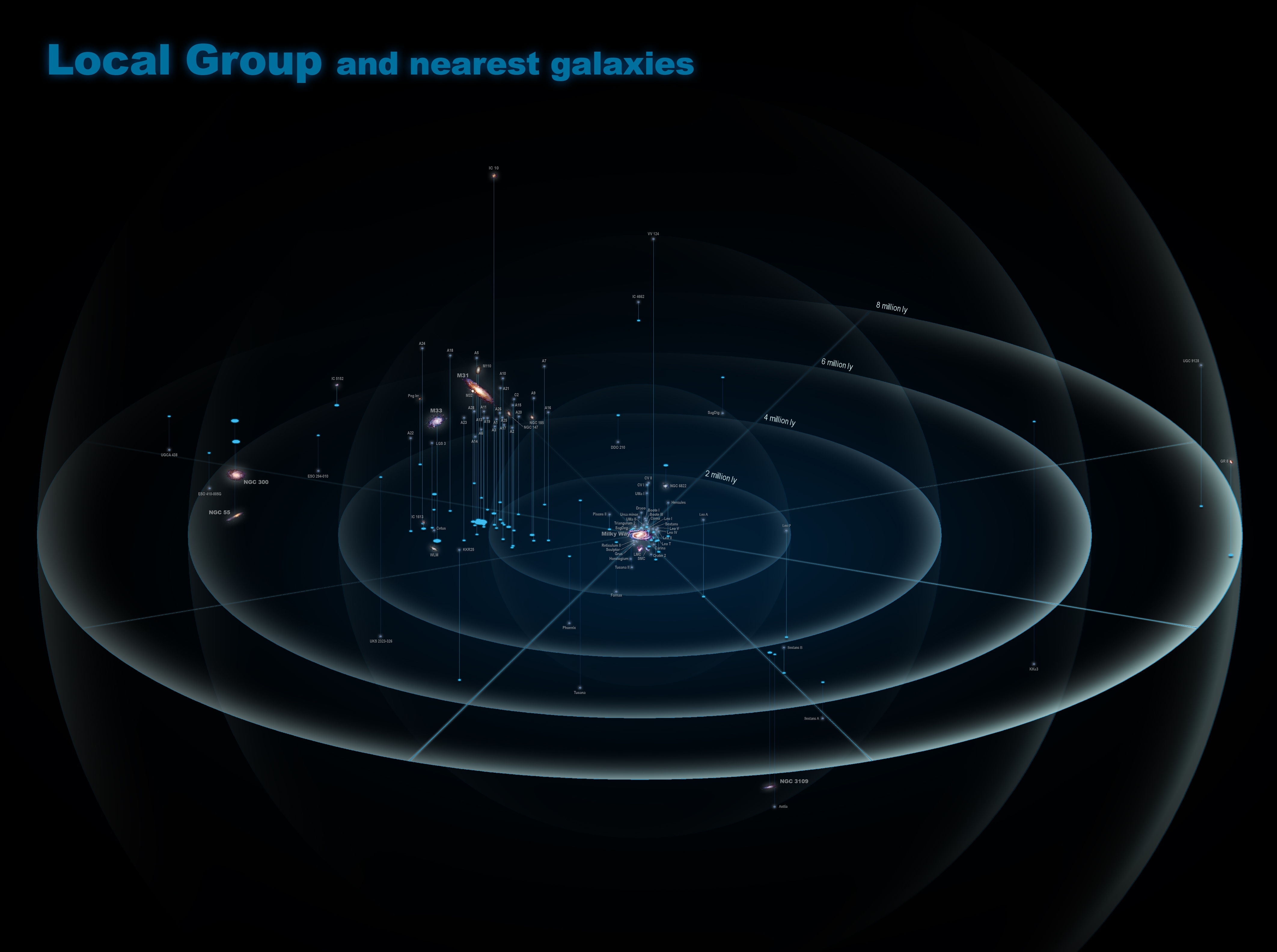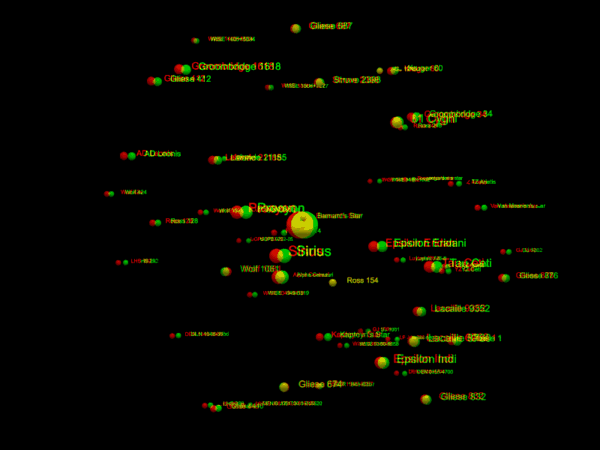Ciro Santilli likes to learn astronomy a bit like he learns geography: go down some lists of "stuff that seems most relevant in some criteria to us!", possibly at different size scales e.g.:
Looking at most astronomical object through a telescope is boring because you only see a white ball or point every time. Such targets would likely only be interesting with spectroscopy analysis.
There are however some objects that you can see the structure of even with an amateur telescope, and that makes them very exciting.
Some good ones:
- The Moon, notably crater detail.
- Saturn. Clearly visible to the naked eye, but looks like a ball. But under an amateur telescope, you can clearly see that there is a disk. Clearly discerning that the disk is a ring, i.e. seeing the gap, is a bit harder though.
- Jupiter. Clearly visible to the naked eye, it is quite huge. The four Galilean moons, being Earth-sized, are incredibly clearly visible, tested on Celestron NexStar 4SE 25mm/9mm eyepiece. Colored gas clouds are hard though, you will likely just see it bright white. www.reddit.com/r/telescopes/comments/35xrbb/how_can_i_see_the_color_of_jupiter_with_my/
- a double star. As mentioned at www.relativelyinteresting.com/10-astronomical-targets-new-telescope/ Albireo are incredibly separated. Also it is is easy to find manually being in a major well known constellation. It is no wonder it is not quite even known if they are gravitationally bound or not!
- Andromeda Galaxy. This is when things start getting hard. You can see a faint cloud, but it is not super clear that it has a center.One important understanding is that it is not possible to see stars outside of the Milky Way by naked eye.It is at this point that you start to learn that pictures of faint objects require longer term exposure and averaging of the images taken. For this you need:Just looking through the scope to immediately see something is not enough.
- a digital camera attached to the scope
- a computerized scope that slowly moves to track the point of interest
- image processing software that does the averaging
Video "Andromeda Galaxy with only a Camera, Lens, & Tripod by Nebula Photos (2020)" gives a good notion of expectation adjustment.
With telescopes however, it is possible. www.quora.com/Can-we-distinguish-individual-stars-in-other-galaxies-or-would-it-be-equivalent-to-say-we-know-there-are-other-forests-of-stars-galaxies-but-we-cant-tell-the-individual-trees-stars-What-is-the-farthest-individual/answer/Jerzy-Micha%C5%82-Pawlak contains an amazing answer that mentions two special cases of the furthest ones:
- gravitational lensing observation
- a star that is far but visible because its light is reflected by a nearby nebulae
But what we can definitely see are globular clusters of galaxies. E.g. the article en.wikipedia.org/wiki/Messier_87 basically gauges the size of galaxies by the number of globular clusters that they contain.
We can't see individual stars outside of the Milky Way:
Any single star outside of the Milky Way cannot be seen.
The Large Magellanic Cloud stands out as the brightest thing we can see from outside the Milky Way by far!
Some stars are so close that we can actually see their angles move with time due to the relative motion between them and the Sun, e.g. Proxima Centauri!
CosmicPI: Detecting Cosmic Rays with a Raspberry Pi by Marco Reps (2021)
Source. - positron, later confirmed with gamma ray experiments by Carl David Anderson
- muon
- pion
- kaon
Sometimes it feels like this could be how we finally make experiments to see what the theory of everything looks like, a bit like the first high energy experiments were from less exotic cosmic rays.
Surely You're Joking, Mr. Feynman chapter An Offer You Must Refuse (a play on words on The Godfather (1972)) has an interesting historical mention from the early 1950s while at Caltech:
The next day, I had the greatest luck in making a decision. God must have set it up to help me decide. I was walking to my office, and a guy came running up to me and said, "Hey, Feynman! Did you hear what happened? Baade found that there are two different populations of stars! All the measurements we had been making of the distances to the galaxies had been based on Cephid variables of one type, but there's another type, so the universe is twice, or three, or even four times as old as we thought!"I knew the problem. In those days, the earth appeared to be older than the universe. The earth was four and a half billion, and the universe was only a couple, or three billion years old. It was a great puzzle. And this discovery resolved all that: The universe was now demonstrably older than was previously thought. And I got this information right away - the guy came running up to me to tell me all this.
To make sense of how it is possible to see this light, you can think of the universe as the expanding raisin bread model, but it expands faster than light (thus the existence of the cosmological event horizon), so we are still receiving light form the middle, not the borders.
CMB is basically perfectly black-body radiation at 2.725 48 K, but it has small variations with variations of the order of 200 microKelvin: cosmic microwave background anisotropy.
There is a slight variation in temperature of CMB across the sky of the order of 200 microKelvin. It is small to the ~2.7 K average temperature, but it can be measured.
If the initial conditions of the Big Bang and the laws of physics were perfectly symmetric, then we could expect the universe to just be one perfectly uniform boring soup.
But instead some asymetry made all the fun weird things we see today happen eventually, like galaxies and life.
And the cosmic microwave background serves as a way for us to look back in time to the early conditions of the universe, as it was set in stone as soon as the universe became transparent to this light during recombination.
Or if you want to get poetic, it is the closest we can ever get to listening to the original word of God when he setup the initial conditions of the universe.
The ansiotropies of CMB is the ultimate astronomical compass we will ever have, as it is the thing with the least proper motion.
Cosmic microwave background anisotropy measured by the Wilkinson Microwave Anisotropy Probe
. Source. Cosmic microwave background anisotropy measured by the Wilkinson Microwave Anisotropy Probe
. Source. What an awesome list the dude compiled. Contains many of the features we care the most about of the sky, since of course, apparent magnitude is a big determinant of that.
Neutron stars are cool. What weird objects!
This is one of those things that when astronomers first saw them they went "oh fuck we've found extraterrestrial life".
Interesting to note that there are quite a few nearer than Sagittarius A, as of 2022 we know of one at 1.5 kly: universemagazine.com/en/discovered-the-closest-black-hole-to-the-sun/
It is interesting that a few months earlier there seemed to be no known specific black holes in the Milky Way: www.nasa.gov/feature/goddard/2022/hubble-determines-mass-of-isolated-black-hole-roaming-our-milky-way-galaxy although their count is estimated to be in the hundreds of millions.
Cover up the entire sky in a compatible way with the traditional constellations. They are also very square, the boundaries consisting only of vertical and horizontal lines on the sphere.
Basically a mini-Constellation.
Radio astronomy is cool because it revealed:The 1974 Nobel Prize in Physics was awarded for pioneering radio astronomy from the late 40s onwards done at the University of Cambridge which was an epicenter of early research in that area, leading to the creation of the Mullard Radio Astronomy Observatory in 1958.
- some very interesting new types of astronomical objects that were not as noticeable in the visible spectrum notably:
- quasars: quasars are extremely redshifted, which means by Hubble's law that they are very far from Earth, so the fact that we could see them at all meant they must have produced immense amounts of light
- pulsars: scientists thought they had found extraterrestrial life when they saw these regularly pulsating signal sources!
- cosmic microwave background which is a major evidence for the Big Bang
- radio wavelengths penetrate Earth's atmosphere better than the visible spectrum making it easier to make ground-based observations
Celestron NexStar SE Tutorial by Astronomia UK (2022)
Source. Meh! ;-)Composed mostly of the Virgo cluster and the Local group.
Some major ones:noirlab.edu/public/images/noao-m49/?nocache=true also lists: M58, M59, M60, M61, M84, M85, M86, M87, M88, M89, M90, M91, M98, M99, and M100 so lots of large and easily observable galaxies in the area.
The basically composed of only the Andromeda Galaxy and the Milky Way. Every other galaxy is a satellite of those two.
First proper nearest galaxy to the Milky Way. Everything in the middle in the Local group is either a satellite of the Milky Way or Andromeda.
As described on Wikipedia, the observational history of Andromeda is fascinating. Little by little, people noticed that it had a different nature to many other objects observed on the sky, and the hypothesis that there are other galaxies like ours grew in force.
Part of our fascination with Andromeda is due to how similar in size and shape and close it is to the Milky Way.
It is clearly the only thing so large and so close.
One can't help but wonder if there is some alien looking back at us when we are looking at them through our telescope.
Andromeda is also the furthest object from Earth that can be seen with the naked eye.[ref] Not surprising, as it literally shines with the strength of a trillion suns!
Andromeda Shun from Saint Seiya performing his Nebula Chain attack
. Source. The original Japanese music actually says "Nebula Chain" in English. The Andromeda Galaxy is shown on the back, the chain appears to go all the way to it and back towards the evil guys' head. Not very relativistic, but so be it.The first proper galaxy near the Milky Way is the Andromeda Galaxy. Everything else in the middle is a satellite of either of of those.
One of the brightest natural objects in the sky, and by far the brightest not in the Milky Way! This is partly because it is relatively close to us.
It is so close that we can notice its proper motion, and its distance to us will vary significantly across a few tens of thousands of years!
This is quite close! But as mentioned at: stars nearest to the Sun, there are several others nearby. Notably Sirius at 9 ly, the brightest star in the sky as of 2020.
Some notable ones:
Articles were limited to the first 100 out of 680 total. Click here to view all children of Astronomy.
Articles by others on the same topic
There are currently no matching articles.






